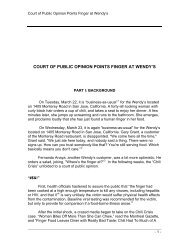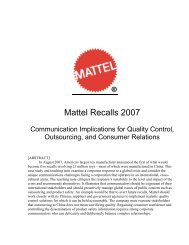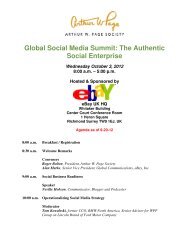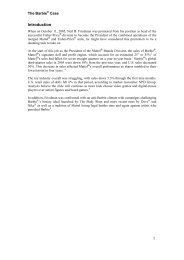The Barbie Case - The Arthur Page Society
The Barbie Case - The Arthur Page Society
The Barbie Case - The Arthur Page Society
You also want an ePaper? Increase the reach of your titles
YUMPU automatically turns print PDFs into web optimized ePapers that Google loves.
were already on a watch list for performance at the time, but<br />
the market timing scandal was the final catalyst to Putnam’s<br />
dismissal. State treasurers from around the country looked to<br />
the Massachusetts decision as an important benchmark<br />
because Putnam was a Boston-based company. When<br />
deciding to fire Putnam, MA state Treasurer Tim Cahill<br />
considered four key questions: 22<br />
1) Was Putnam’s investment performance satisfactory?<br />
2) Did they have a clear understanding of all ethically<br />
questionable trading activity that had taken place at<br />
the firm?<br />
3) Had they done enough to ensure that such actions<br />
would not take place in the future?<br />
4) Did they come clean and fully admit their wrongdoing?<br />
From Cahill’s perspective, there was no decision to be made<br />
about the $1 billion invested in the international portfolios<br />
where market timing took place. It had to be pulled. But, the<br />
state also had $800 million invested in small cap portfolios<br />
managed by Putnam that were not directly implicated in the<br />
trading scandal. If the questions regarding Putnam’s<br />
knowledge, response and accountability could be answered<br />
satisfactorily, perhaps these assets could remain with the<br />
company.<br />
At the time of the firing, Cahill also thought carefully about<br />
what criteria he would use to decide whether to rehire<br />
Putnam in the future. “If I was going to fire Putnam for<br />
issues surrounding performance, trust and accountability, I<br />
had to be willing to re-hire them for the same reasons. It was<br />
not fair to punish them forever.” 23 For Cahill, it was critical<br />
that Putnam not only improve its performance and protect<br />
against future wrongdoing, but also that the company make<br />
strides in changing their culture. He agreed with the critics<br />
who perceived Putnam’s “greed-oriented” culture as a<br />
contributor to both the market timing activity itself and the<br />
firm’s inability to handle it effectively. “I needed to see that<br />
they got it.” 24<br />
Sophisticated Private Funds<br />
Putnam regarded their large private fund clients as thought<br />
leaders in money management and asset allocation.<br />
Managers of these assets were focused on investment<br />
performance and, by the end of 2003, readily understood why<br />
market timing by portfolio managers was both unethical and<br />
arthur w. page society<br />
costly to fund shareholders. IBM, the first major private<br />
institution to pull its money from Putnam, regarded the<br />
firing decision as inevitable once the facts of the scandal<br />
became public. <strong>The</strong>re was little downside to moving their<br />
money to index funds while Putnam’s conduct was evaluated<br />
by regulators and the court of public opinion. 25<br />
<strong>The</strong> very largest plans (IBM, GM etc.) rarely used investment<br />
consultants* because they had large enough in-house staffs to<br />
do the investment work themselves. Nonetheless, they<br />
frequently leaned on the ratings of independent research<br />
firms like Wilshire and Russell. Because investments in buyrated<br />
funds stand up to scrutiny during times of substandard<br />
performance, these ratings served as an important<br />
guide-post for even the savviest of institutional managers.<br />
<strong>The</strong>se ratings are largely formulaic and they can be<br />
unforgiving. <strong>The</strong> departure of a senior investment<br />
professional results in an automatic ratings downgrade (i.e.,<br />
from “buy” to “hold”) in both the Wilshire and Russell<br />
measurement systems. <strong>The</strong> departure of two senior<br />
professionals, as was the case with Putnam, doubled the<br />
magnitude of the downgrade (i.e., from “buy” to “sell”).<br />
<strong>The</strong>refore, Putnam’s assets under management at<br />
sophisticated private funds were in serious jeopardy regardless<br />
of how forthrightly they addressed the market timing issue<br />
with their clients. “<strong>The</strong>y were going to leave us anyway. Our<br />
approach to communicating with them would only impact<br />
future fund flows, but the damage had been done.” 26<br />
Consultant-Advised Private Funds<br />
Many private funds use third party advisors such as<br />
Cambridge Associates to determine where to invest their<br />
money. Cambridge, much like the managers of large private<br />
funds, is focused on the mechanics of the investment process<br />
as an important indicator of quality in rating different<br />
mutual funds and managers. Accordingly, the departure of<br />
two senior portfolio managers will significantly impact<br />
Cambridge’s assessment of a particular mutual fund or fund<br />
company. Moreover, advisors are vulnerable to being sued<br />
for putting clients’ money into funds where legal violations<br />
have taken place. <strong>The</strong>refore, the near-term fallout would<br />
likely be severe in consultant advised funds regardless of<br />
Putnam’s handling of the crisis. Longer-term, consultants’<br />
assessment of Putnam funds would, at least in part, be<br />
determined by how they dealt with the market timing scandal.<br />
*Investment consultants act as independent third party advisors to assist institutions in the<br />
allocation of their investments. Consultants rate fund managers and suggest where their clients<br />
should invest their money (i.e., Putnam vs. Fidelity, stocks vs. bonds, domestic vs. international).<br />
21














